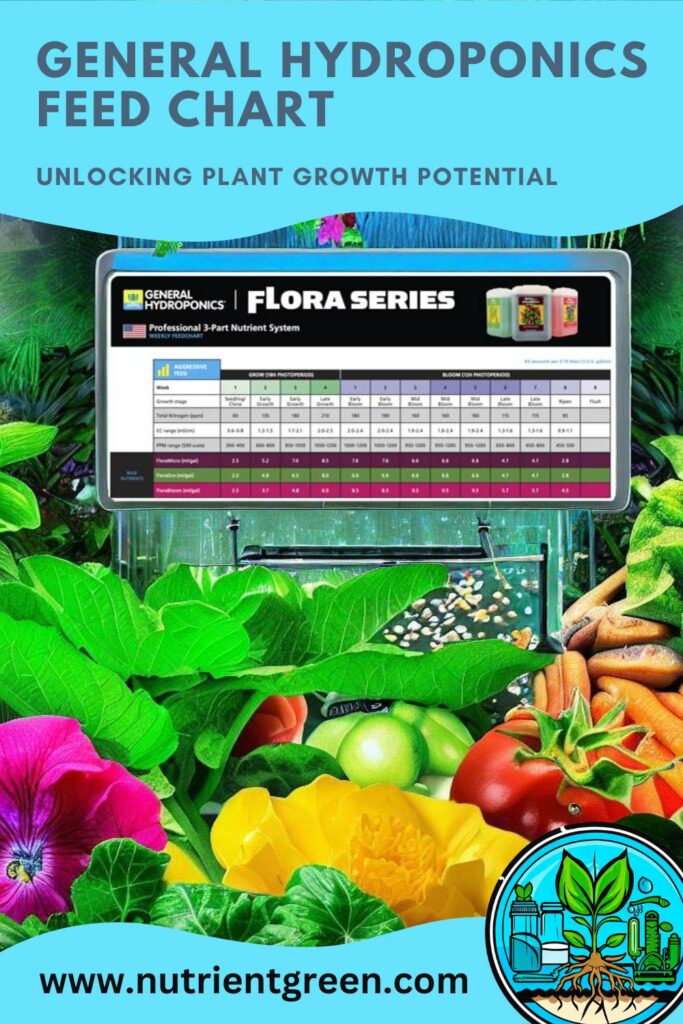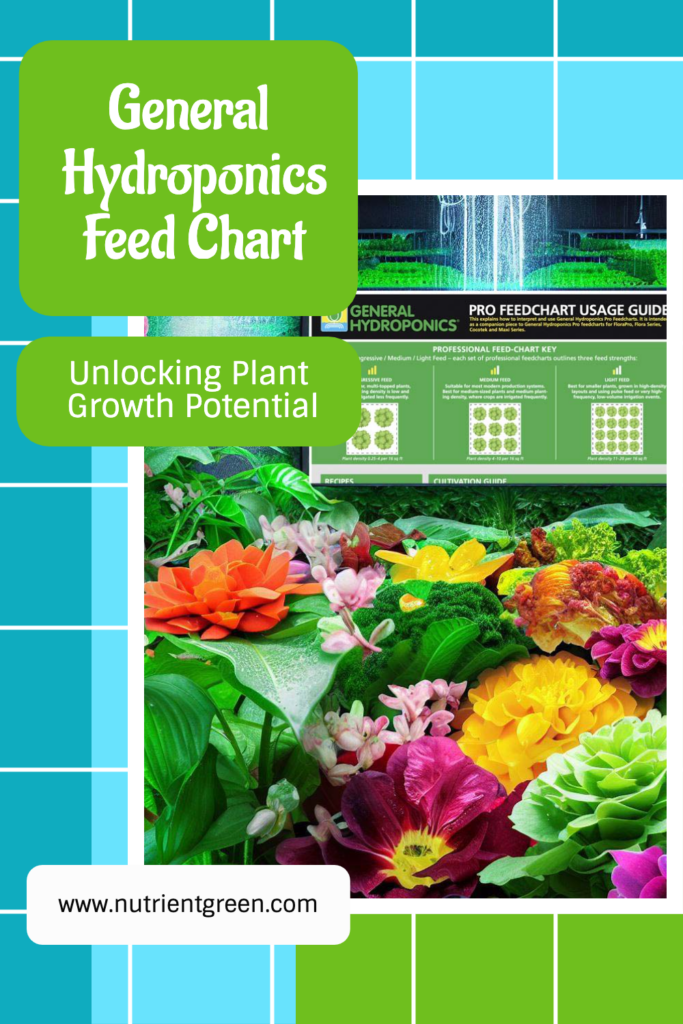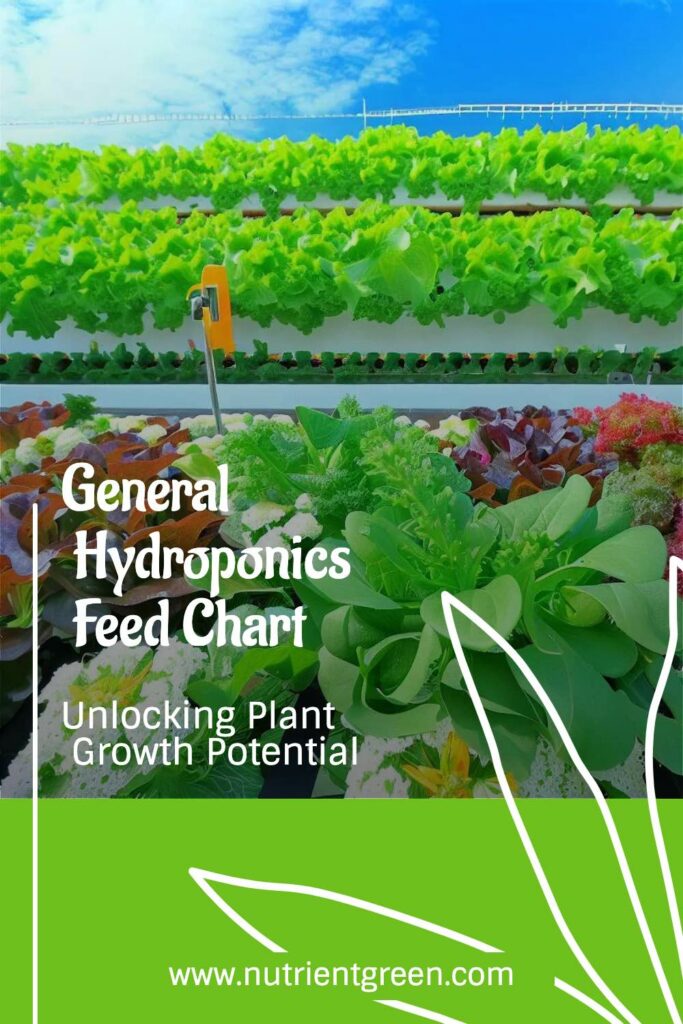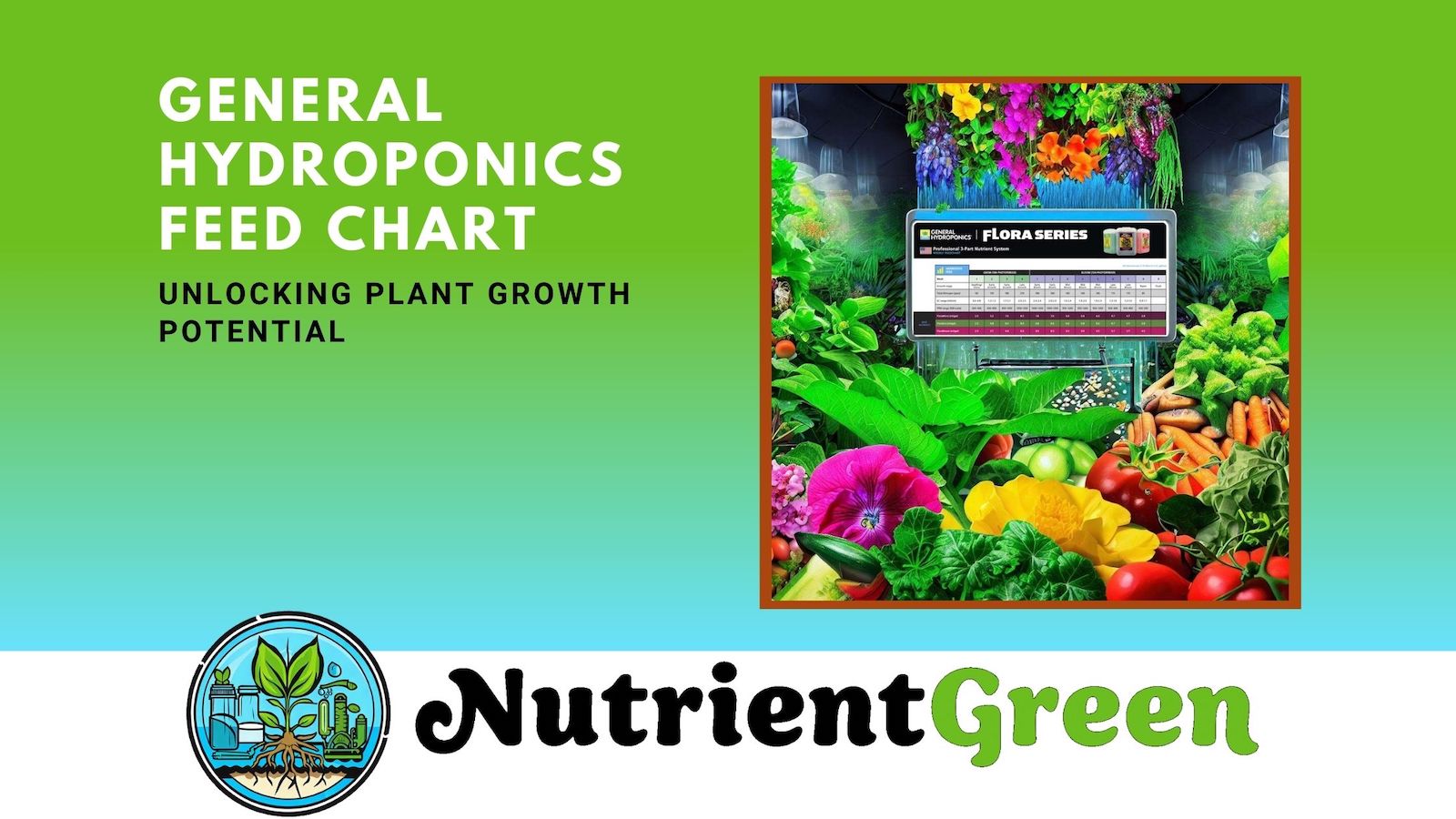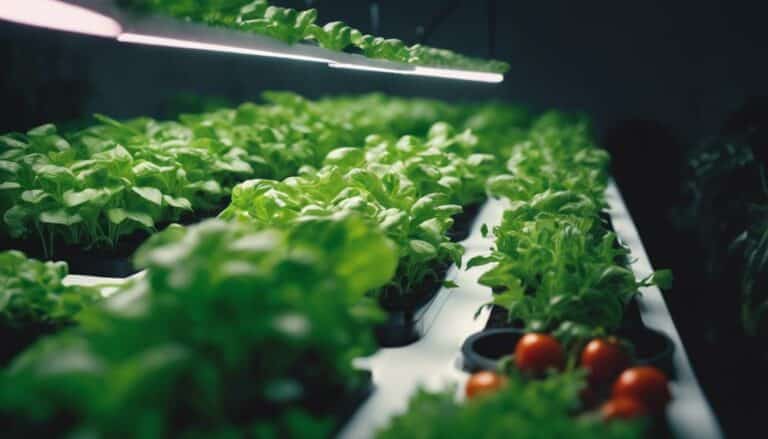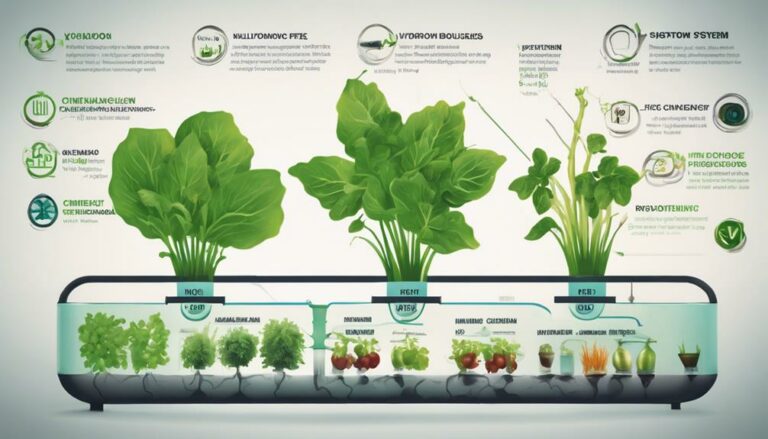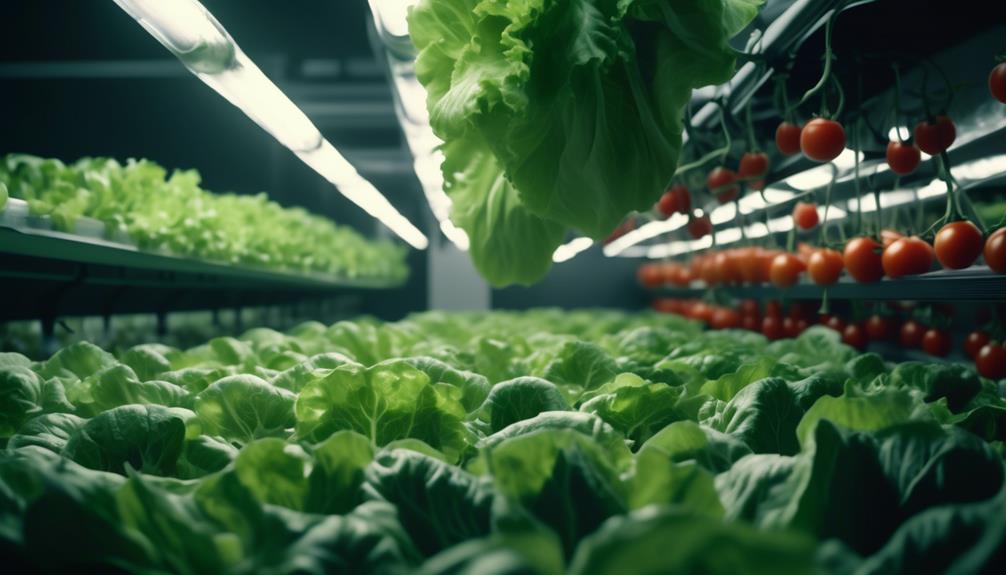If you’re new to hydroponic gardening, you may have questions about properly nourishing your plants. Unlike traditional soil-based gardening, hydroponic plants rely on a nutrient solution to provide them with the essential elements necessary for optimal growth. But how can you determine the right nutrients, quantities, and timing? This is where the general hydroponics feed chart becomes invaluable.
Table of Contents
Introduction
Acting as a guide, it outlines the specific nutrients and extra supplements required for each stage of your plants’ life cycle. It provides instructions on proper mixing techniques and advises on adjusting water quality accordingly.
Within this article, we’ll explore why it is essential, how to select the right one, and most importantly, how to utilize it effectively. Additionally, we will share valuable tips and tricks to ensure remarkable results when feeding your hydroponic plants. By the end, you’ll possess a comprehensive understanding of nourishing your plants and achieving exceptional outcomes. We will examine the Flora Series chart in greater detail. This chart is versatile and suitable for use in various growing mediums, including soil, coco coir, aeroponics, and hydroponics.
If you’re a hydro cultivator or prefer growing cannabis seeds in a sterile medium like coco fiber, perlite, rock wool, or clay pellets, continue reading to discover the components of GH nutrients, their application techniques, valuable tips, and our suggested feeding schedule tailored for both novice and experienced growers!
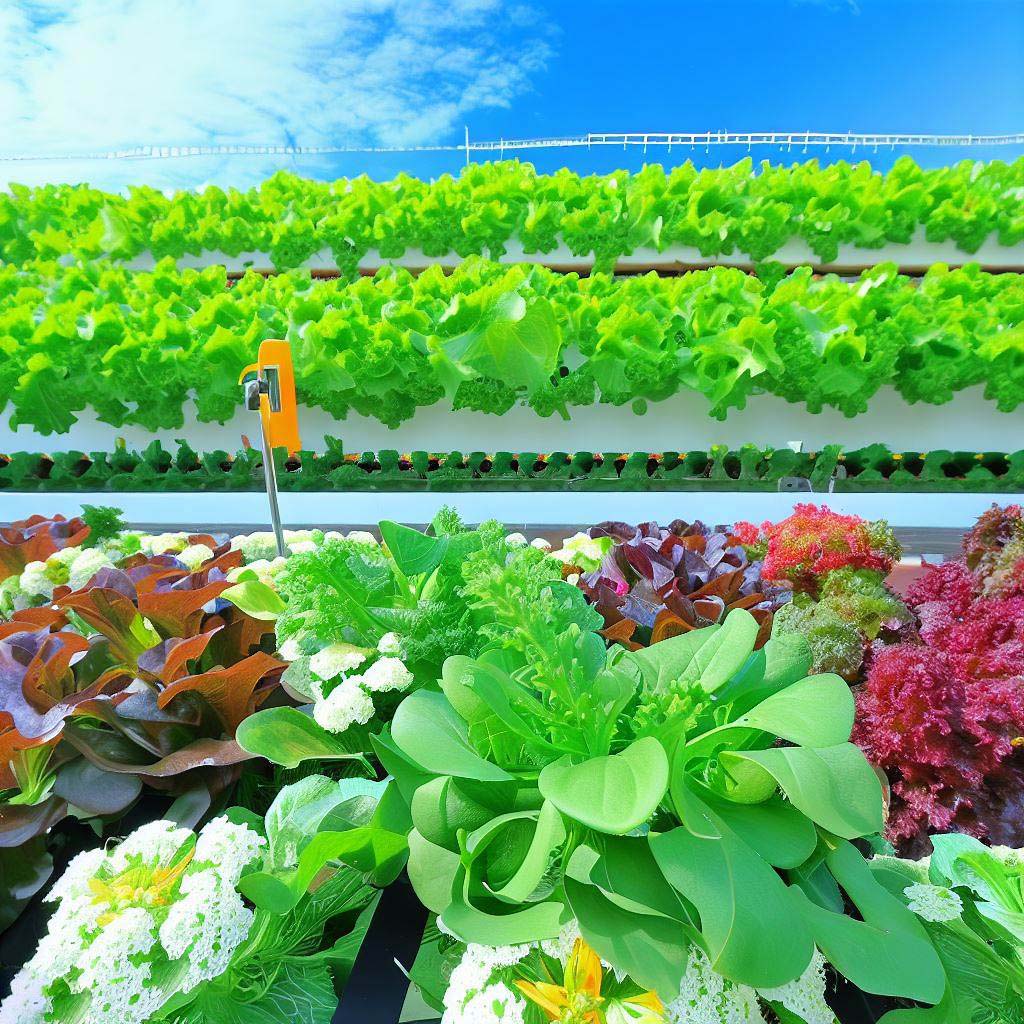
What is the General Hydroponics Feed Chart?
The General Hydroponics Feed Chart is an invaluable resource designed to assist hydro cultivators in utilizing the range of nutrients and supplements offered by General Hydroponics. With over four decades of experience, GH has established itself as a trusted brand in the gardening industry. Their feed chart provides comprehensive guidance tailored to various hydroponic systems and crops.
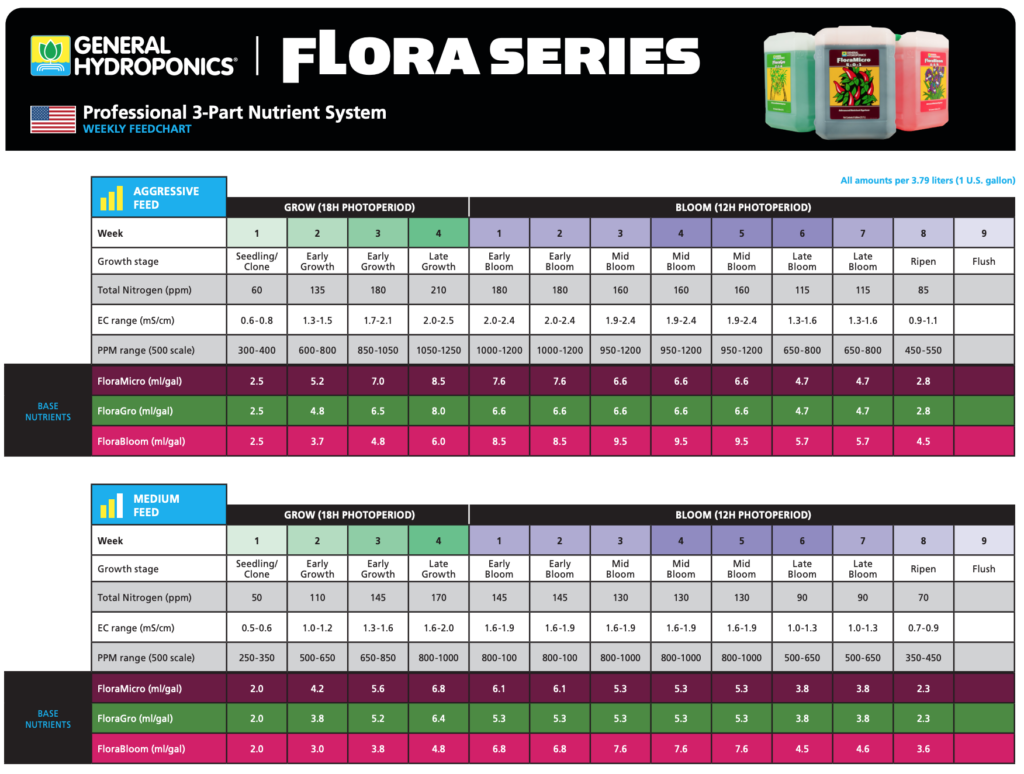
This document serves as a roadmap, offering precise instructions on the selection, quantity, timing, and mixing of the appropriate GH products. It ensures that growers understand the specific requirements for their plants, enabling them to achieve optimal performance. Moreover, the feed chart provides essential information on maintaining crucial water quality parameters, such as pH and EC, ensuring the ideal growing environment.
Drawing from scientific research and insights from experienced cultivators, the General Hydroponics Feed Chart embodies a wealth of knowledge and expertise. By following this chart, horticulturists can confidently nourish their hydroponic plants and maximize their potential for success.
Why You Need a Feed Chart for Your Plants
Understanding why a feeding chart is essential for your hydro plants is crucial. Following generic formulas or instructions on nutrient bottles may not provide the best outcomes. Here are key reasons why you need such a chart:
- Precise Nutrient Timing: Each growth stage of your plants demands specific Plant nourishment. A chart guides you on providing the right nutrients at the appropriate times. For instance, seedlings require more nitrogen, while flowering plants benefit from increased phosphorus and potassium levels. By adhering to the feed chart, you can meet your plants’ changing needs effectively.
- Preventing Nutrient Imbalances: Nutrient deficiencies or toxicities can harm your plants’ health, growth, and yield. A feed chart ensures that you use the correct amounts of nutrients, preventing underfeeding or overfeeding. It considers your water volume and quality, enabling you to provide the optimal nutrient concentrations for your plants’ well-being.
- Optimizing Water Quality: Soft Water quality profoundly impacts Plant nourishment uptake and plant metabolism. pH levels that are too high or too low, excessive or insufficient mineral content, can impede nutrient absorption, leading to nutrient lockout or imbalances. A chart provides guidance on adjusting pH and EC levels within your solution. This empowers you to maintain an ideal water quality environment for your plants‘ success.
By embracing a fertilizer regimen, you ensure your hydro plants receive the right nutrients at the right time, avoid nutrient-related issues, and optimize their overall growth and productivity.
How to Choose the Right Chart for Your Growing System
To select the appropriate fertilizer regimen for your specific hydroponic growing system, consider the following factors:
- Hydroponic System Type: Different hydro systems, such as drip systems, aeroponic systems, or nutrient film technique (NFT) systems, have distinct characteristics and requirements. Factors like water flow, aeration, drainage, and reservoir size impact feeding frequency, concentrations, and water usage.
- Plant Variety: Plants vary in their nutrient preferences and requirements based on species, variety, and growth stage. For instance, lettuce may require fewer nutrients compared to calcium-demanding tomatoes. Consider the specific needs of your plant varieties to align with the appropriate fertilizer regimen.
- Nutrients and Supplements: Various brands and product lines offer different nutrient formulations and concentrations. GH, for instance, provides FloraSeries, FloraPro, and Maxi Series nutrients, each with its own advantages and specific feed chart. Ensure the chart aligns with the nutrients and supplements you are using, enabling accurate mixing, measuring, and adjustments to water quality. One frequently used supplemental product is CaliMagic, which serves to augment the calcium and magnesium levels in your solution.
To find a suitable feed chart, consult General Hydroponics’ website or their product literature. Take into account your system type, plant variety, and the nutrients and supplements you use. Matching these factors will enable you to choose the right feed chart for your growing system, optimizing your plants’ growth and yield potential. Several fertilizers and additives mentioned in this list have the capability to automatically adjust the pH levels in your nutrient solution. Nevertheless, it is advisable to monitor the pH periodically to ensure it remains within the desired range.
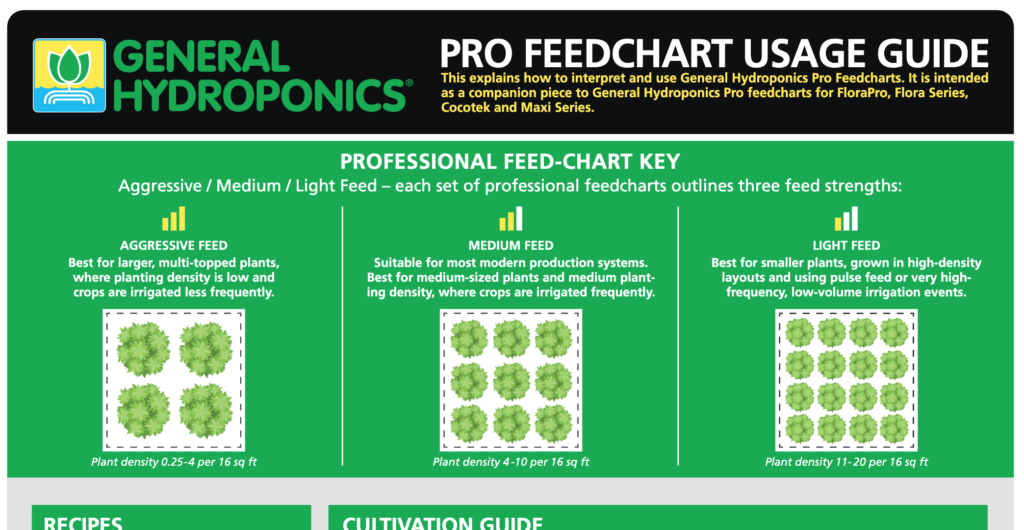
Types of General Hydroponics Feed Chart
As we mentioned earlier, GH offers three main types of Plant nourishment: FloraSeries, FloraPro, and Maxi Series. Their primary product line encompasses nutrients designed for both hydroponic and soil-based gardens, featuring prominent items like the Flora Series 3-Part Nutrient System and Micro Nutrient Series. Additionally, they provide a diverse array of additives and supplementary products suitable for various applications.
Each type has its own feed chart that tells you how to use it for your plants. Let’s take a closer look at each type and its chart.
FloraSeries 3-Part Feed Chart
FloraSeries is the original 3-part hydro-based nutrient system that consists of three products: FloraGro (for vegetative growth), FloraMicro (for micronutrients), and FloraBloom (for flowering and fruiting). FloraSeries is designed to be versatile and adaptable for different types of plants and systems.
The comprehensive Flora Series nutrients offer the flexibility to effectively meet your plants’ evolving requirements. You can achieve this by adjusting the composition and timing of their growth. Therefore, it is advisable to increase usage during the growth phase and reduce it during the flowering stage to optimize results.
FloraSeries 3-part feed chart offers three options: basic, performance, and custom. Each option has its own benefits and drawbacks, depending on your goals and preferences.
| FloraSeries 3-Part Feed Chart | Basic | Performance | Custom |
|---|---|---|---|
| FloraMicro | 2.5 ml/L or 0.5 tsp/gal | Varies by growth stage: 2.5 ml/L or 0.5 tsp/gal (vegetative), 2 ml/L or 0.4 tsp/gal (transition), 1.5 ml/L or 0.3 tsp/gal (flowering) | Any amount you want |
| FloraGro | 2.5 ml/L or 0.5 tsp/gal | Varies by growth stage: 2.5 ml/L or 0.5 tsp/gal (vegetative), 1 ml/L or 0.2 tsp/gal (transition), 0 ml/L or 0 tsp/gal (flowering) | Any amount you want |
| FloraBloom | 2.5 ml/L or 0.5 tsp/gal | Varies by growth stage: 0 ml/L or 0 tsp/gal (vegetative), 1 ml/L or 0.2 tsp/gal (transition), 2.5 ml/L or 0.5 tsp/gal (flowering) | Any amount you want |
| Supplements (optional) | RapidStart, Floralicious Plus, Liquid KoolBloom, Dry KoolBloom, FloraBlend, FloraKleen | RapidStart, Floralicious Plus, Liquid KoolBloom, Dry KoolBloom, FloraBlend, FloraKleen (mandatory) | RapidStart, Floralicious Plus, Liquid KoolBloom, Dry KoolBloom, FloraBlend, FloraKleen (optional) |
| Feed strength | Medium (2.5 ml/L or 0.5 tsp/gal of each product) | Aggressive (3 ml/L or 0.6 tsp/gal of each product), Medium (2 ml/L or 0.4 tsp/gal of each product), Light (1 ml/L or 0.2 tsp/gal of each product) | Any strength you want |
| Feed schedule | Weekly (7 d/w) | Weekly (7 d/w) or Growth Stage (vegetative, transition, flowering) | Weekly (7 d/w) or Growth Stage (vegetative, transition, flowering) |
Basic Feed Chart
The basic feed chart offers a convenient and uncomplicated option for hydro cultivators. It provides instructions to use three products in equal proportions consistently throughout the plants’ entire growth cycle. Additionally, it suggests optional supplements for added benefits.
This chart particularly caters to beginners seeking a simple and straightforward solution that suits most plants and systems. It is also advantageous for those aiming to streamline their operations and reduce costs by utilizing fewer products.
However, it is important to note that the basic feed chart may lack flexibility and precision when it comes to accommodating diverse plant types and systems. It doesn’t account for the varying nutrient requirements of different plants at different growth stages. Moreover, it does not consider the distinct water quality parameters of different hydroponic systems. Excessive levels of calcium and magnesium in water, often referred to as “total hardness,” can lead to significant issues. For growers seeking more tailored and precise base nutrients solutions, exploring alternative feed charts may be beneficial.
| Basic Feed Chart | FloraMicro | FloraGro | FloraBloom | Supplements (optional) |
|---|---|---|---|---|
| Seedling/Clone | 2.5 ml/L or 0.5 tsp/gal | 2.5 ml/L or 0.5 tsp/gal | 2.5 ml/L or 0.5 tsp/gal | RapidStart |
| Vegetative | 2.5 ml/L or 0.5 tsp/gal | 2.5 ml/L or 0.5 tsp/gal | 2.5 ml/L or 0.5 tsp/gal | RapidStart, Floralicious Plus |
| Transition | 2.5 ml/L or 0.5 tsp/gal | 2.5 ml/L or 0.5 tsp/gal | 2.5 ml/L or 0.5 tsp/gal | RapidStart, Floralicious Plus, Liquid KoolBloom |
| Flowering | 2.5 ml/L or 0.5 tsp/gal | 2.5 ml/L or 0.5 tsp/gal | 2.5 ml/L or 0.5 tsp/gal | RapidStart, Floralicious Plus, Liquid KoolBloom, Dry KoolBloom |
| Flush/Ripen | 0 ml/L or 0 tsp/gal | 0 ml/L or 0 tsp/gal | 0 ml/L or 0 tsp/gal | FloraKleen |
Performance Feed Chart
The performance feed chart represents an elevated option that offers enhanced flexibility and precision compared to the basic chart. This chart provides guidelines on adjusting the proportions of the three products based on the specific growth stage of your plants. During the vegetative phase, it suggests a higher proportion of FloraGro, followed by an equal ratio of FloraGro and FloraBloom during the transition stage, and a higher proportion of FloraBloom during the flowering phase. Furthermore, it highlights mandatory supplement usage for optimal results.
The performance feed chart caters to intermediate cultivators seeking greater control and customization over their nutrient solution, aligning it with their plants’ requirements and system characteristics. It is also beneficial for those aiming to achieve higher yields and superior quality by incorporating additional products.
However, it is important to note that the performance feed chart presents a more intricate and expensive approach compared to the basic feed chart. It demands increased attention and adjustment to the nutrient solution throughout the plants’ growth cycle. Additionally, it requires additional water usage and storage space for the supplementary products. Indeed, this method is straightforward and highly effective, particularly for cannabis plants.
| Performance Feed Chart | FloraMicro | FloraGro | FloraBloom | Supplements (mandatory) |
|---|---|---|---|---|
| Seedling/Clone | 2.5 ml/L or 0.5 tsp/gal | 2.5 ml/L or 0.5 tsp/gal | 0 ml/L or 0 tsp/gal | RapidStart |
| Vegetative | 2.5 ml/L or 0.5 tsp/gal | 2.5 ml/L or 0.5 tsp/gal | 0 ml/L or 0 tsp/gal | RapidStart, Floralicious Plus, FloraBlend |
| Transition | 2 ml/L or 0.4 tsp/gal | 1 ml/L or 0.2 tsp/gal | 1 ml/L or 0.2 tsp/gal | RapidStart, Floralicious Plus, FloraBlend, Liquid KoolBloom |
| Flowering | 1.5 ml/L or 0.3 tsp/gal | 0 ml/L or 0 tsp/gal | 2.5 ml/L or 0.5 tsp/gal | RapidStart, Floralicious Plus, FloraBlend, Liquid KoolBloom, Dry KoolBloom |
| Flush/Ripen | 0 ml/L or 0 tsp/gal | 0 ml/L or 0 tsp/gal | 0 ml/L or 0 tsp/gal | FloraKleen |
Custom Feed Chart
The custom feed chart represents the epitome of advanced and sophisticated options, offering unparalleled flexibility and precision. It grants horticulturists complete control and customization over their nutrient solution, tailoring it precisely to their plants’ requirements and system characteristics. The chart allows for the utilization of the three products in any desired proportions, while optional supplements provide additional benefits.
Designed for expert horticulturists seeking utmost control and customization, the custom feed chart caters to specific situations with precision. It is also well-suited for growers who embrace experimentation and seek to optimize their nutrient solution for exceptional outcomes.
However, it is important to acknowledge that the custom feed chart is the most challenging and potentially risky option. Creating and utilizing a custom nutrient solution demands extensive knowledge and experience. It necessitates thorough testing and meticulous monitoring to ensure a well-balanced and effective nutrient solution for your plants and systems. The custom chart is reserved for cultivators who possess the expertise and dedication to navigate its complexities and risks effectively.
| Custom Feed Chart | FloraMicro | FloraGro | FloraBloom | Supplements (optional) |
|---|---|---|---|---|
| Seedling/Clone | Any amount you want | Any amount you want | Any amount you want | RapidStart |
| Vegetative | Any amount you want | Any amount you want | Any amount you want | RapidStart, Floralicious Plus, FloraBlend |
| Transition | Any amount you want | Any amount you want | Any amount you want | RapidStart, Floralicious Plus, FloraBlend, Liquid KoolBloom |
| Flowering | Any amount you want | Any amount you want | Any amount you want | RapidStart, Floralicious Plus, FloraBlend, Liquid KoolBloom, Dry KoolBloom |
| Flush/Ripen | 0 ml/L or 0 tsp/gal | 0 ml/L or 0 tsp/gal | 0 ml/L or 0 tsp/gal | FloraKleen |
FloraPro Feed Chart
FloraPro, a 2-part powder-based nutrient system, offers convenience and cost-effectiveness for large-scale commercial horticulturists. Consisting of FloraPro Grow for vegetative growth and FloraPro Bloom for flowering and fruiting, this system simplifies fertilizer management.
The FloraPro feed chart provides instructions on adjusting the proportions of the two products based on the growth stage of the plants. During the vegetative phase, a higher ratio of FloraPro Grow is recommended, followed by an equal ratio of FloraPro Grow and FloraPro Bloom during the transition stage. Lastly, a higher proportion of FloraPro Bloom is suggested for the flowering phase. Optional supplement usage is also suggested for additional benefits.
The FloraPro feed chart is well-suited for commercial growers seeking a straightforward and cost-effective solution that accommodates various plants and systems. Additionally, it appeals to cultivators aiming to conserve space and water by utilizing powder-based products.
However, it is important to note that the FloraPro feed chart may lack the flexibility and precision required for different plant types and systems. It does not account for the varying fertilizer requirements of plants at different growth stages, nor does it consider the diverse water quality parameters across different hydroponic systems. For horticulturists seeking a more tailored approach, exploring alternative feed charts may be necessary.
| FloraPro Feed Chart | FloraPro Grow | FloraPro Bloom | FloraPro Calcium + Micros | Supplements (optional) |
|---|---|---|---|---|
| Seedling/Clone | 0.5 g/L or 0.1 tsp/gal | 0 g/L or 0 tsp/gal | 1 g/L or 0.2 tsp/gal | RapidStart |
| Vegetative | 1 g/L or 0.2 tsp/gal | 0 g/L or 0 tsp/gal | 1 g/L or 0.2 tsp/gal | RapidStart, Floralicious Plus, FloraBlend |
| Transition | 0.5 g/L or 0.1 tsp/gal | 0.5 g/L or 0.1 tsp/gal | 1 g/L or 0.2 tsp/gal | RapidStart, Floralicious Plus, FloraBlend, Liquid KoolBloom |
| Flowering | 0 g/L or 0 tsp/gal | 1 g/L or 0.2 tsp/gal | 1 g/L or 0.2 tsp/gal | RapidStart, Floralicious Plus, FloraBlend, Liquid KoolBloom, Dry KoolBloom |
| Flush/Ripen | 0 g/L or 0 tsp/gal | 0 g/L or 0 tsp/gal | 0 g/L or 0 tsp/gal | FloraKleen |
Maxi Series Feed Chart
The Maxi Series is a 2-part dry concentrate fertilizer system that includes MaxiGro for vegetative growth and MaxiBloom for flowering and fruiting stages. With its simplicity and versatility, the Maxi Series is designed to cater to various plant types and systems.
The Maxi Series feed chart provides guidance on adjusting the proportions of MaxiGro and MaxiBloom based on the specific growth stage of the plants. During the vegetative phase, a higher proportion of MaxiGro is recommended, followed by an equal ratio of MaxiGro and MaxiBloom during the transition stage. For the flowering phase, a higher proportion of MaxiBloom is suggested. Optional supplement usage is also mentioned for added benefits.
The Maxi Series feed chart is well-suited for hobbyist growers seeking a straightforward and adaptable solution that accommodates different plant types and systems. It is also beneficial for those looking to conserve space and water by utilizing dry concentrate products.
However, it is important to note that the Maxi Series feed chart may lack the flexibility and precision required for the specific nutrient needs of different plants and systems. It does not account for the varying requirements of plants at different growth stages or consider the diverse water quality parameters present in different hydroponic systems. For cultivators seeking a more tailored approach, exploring alternative feed charts may be necessary.
| Maxi Series Feed Chart | MaxiGro | MaxiBloom | Supplements (optional) |
|---|---|---|---|
| Seedling/Clone | 1 g/L or 0.2 tsp/gal | 0 g/L or 0 tsp/gal | RapidStart |
| Vegetative | 1.5 g/L or 0.3 tsp/gal | 0 g/L or 0 tsp/gal | RapidStart, Floralicious Plus, FloraBlend |
| Transition | 1 g/L or 0.2 tsp/gal | 1 g/L or 0.2 tsp/gal | RapidStart, Floralicious Plus, FloraBlend, Liquid KoolBloom |
| Flowering | 0 g/L or 0 tsp/gal | 1.5 g/L or 0.3 tsp/gal | RapidStart, Floralicious Plus, FloraBlend, Liquid KoolBloom, Dry KoolBloom |
| Flush/Ripen | 0 g/L or 0 tsp/gal | 0 g/L or 0 tsp/gal | FloraKleen |
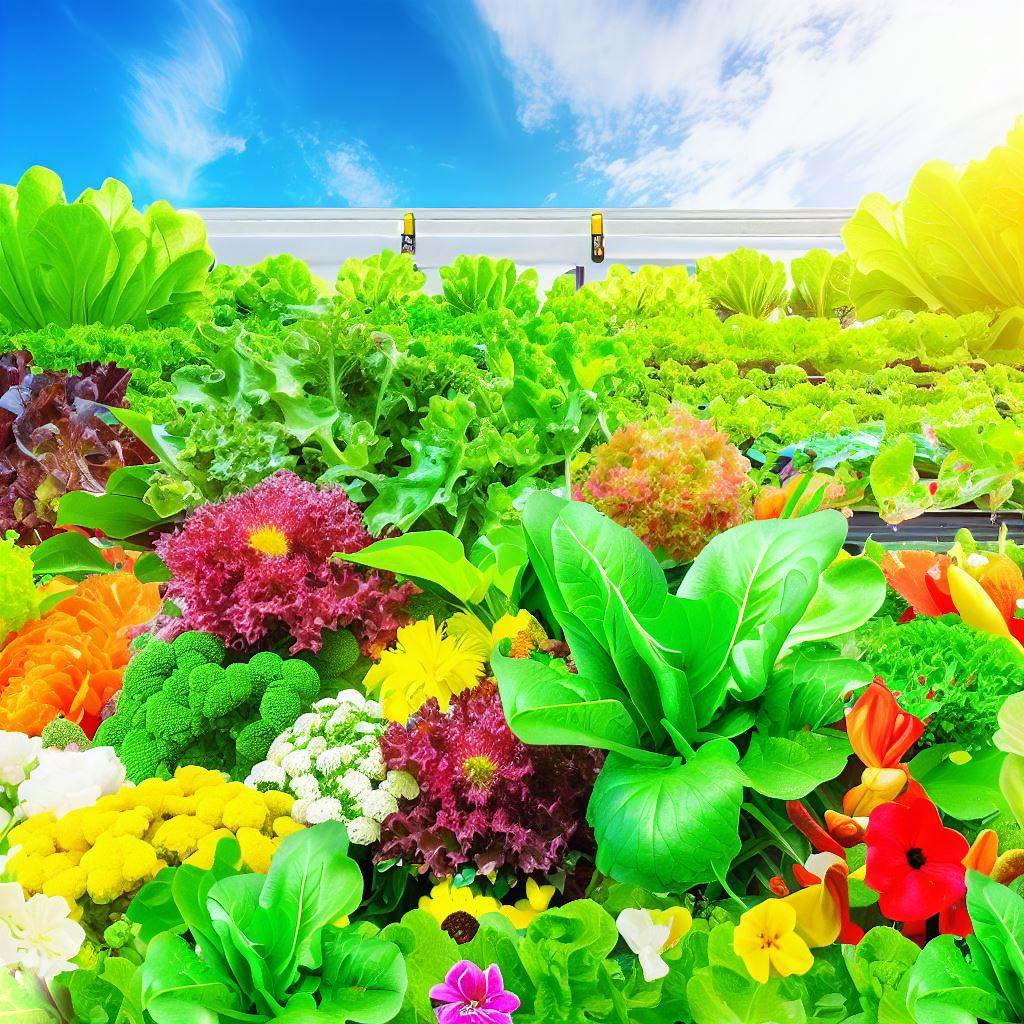
How to Use a General Hydroponics Feed Chart
Now that you know what types of GH feed charts are available, you might be wondering how to use them.
Here are some general steps on how to use a general hydroponics feed chart:
Step 1: Measure Your Water Volume and Quality
The first step is to measure your water volume and quality before you add any nutrients or supplements. You need to know how much water you are using, as well as its pH and EC levels.
Water volume is important because it determines how much Mineral supplement you need to use. You can measure your water volume by using a measuring cup, a bucket, or a scale. It’s essential to consistently measure the ppm (parts per million) of your solution before irrigating your crop.
pH is important because it affects your plants’ ability to absorb nutrients. pH stands for potential hydrogen, which measures how acidic or alkaline your water is on a scale from 0 to 14. The ideal pH range for most hydroponic plants is between 5.5 and 6.5. You can measure your pH by using a pH meter, a pH test kit, or a pH indicator solution.
EC is important because it affects your plants’ tolerance to mineral. EC stands for electrical conductivity, which measures how much salt or dissolved solids are in your water on a scale from 0 to 10,000 microsiemens per centimeter (µS/cm). The ideal EC range for most hydro plants is between 500 and 1500 µS/cm. You can measure your EC by using an EC meter, an EC test kit, or an EC indicator solution.
Step 2: Select Your Feed Strength and Schedule
The second step is to select your feed strength and schedule based on your feed chart. Feed strength refers to how concentrated your nutrient solution is, while feed schedule refers to how often you feed your plants.
Feed strength is important because it affects your plants’ growth and development. Feed strength is usually expressed in milliliters per liter (ml/L) or teaspoons per gallon (tsp/gal) of each product. The ideal feed strength for most hydroponic plants is between 1 and 3 ml/L or 0.2 and 0.6 tsp/gal of each product. You can adjust your feed strength by adding more or less of each product according to your feed chart.
Feed schedule is important because it affects your plants’ nutrient uptake and metabolism. Feed schedule is usually expressed in days per week (d/w) or times per day (t/d) of feeding. The ideal feed schedule for most hydroponic plants is between 3 and 7 d/w or 1 and 3 t/d of feeding. You can adjust your feed schedule by feeding more or less frequently according to your feed chart.
Step 3: Mix Your Nutrients and Supplements According to the Chart
The third step is to mix your Fertilizer and supplements according to the chart. You need to follow the order of mixing as indicated on the chart, as well as the instructions on the product labels.
Order of mixing is important because it affects the stability and compatibility of your nutrient solution. It is usually expressed in numbers or letters that correspond to each product. The general order of mixing for most GH products is:
- FloraMicro or FloraPro Micro
- FloraGro or FloraPro Grow
- FloraBloom or FloraPro Bloom
- MaxiGro or MaxiBloom
- Supplements
Instructions on the product labels are important because they provide you with specific information on how to use each product. These labels usually include:
- How much of each product to use per water volume
- How to measure and mix each product
- How to store and handle each product
- How to dispose of each product
Step 4: Adjust Your pH and EC Levels as Needed
The fourth step is to adjust your pH and EC levels as needed after you mix your mineral supplement. You need to check your pH and EC levels again by using the same tools as before, and compare them with the ideal ranges for your plants.
pH adjustment is important because it affects your plants’ ability to absorb nutrients. pH adjustment is usually done by adding pH up or pH down products that raise or lower your pH level respectively. The general rule of thumb for pH adjustment is:
- If your pH is too high (above 6.5), add pH down
- If your pH is too low (below 5.5), add pH up
- If your pH is within the ideal range (between 5.5 and 6.5), do not add anything
EC adjustment is important because it affects your plants’ tolerance to salt. This is usually done by adding more water or more mineral supplement that dilute or increase your EC level respectively. The general rule of thumb is:
- If your EC is too high (above 1500 µS/cm), add more water
- If your EC is too low (below 500 µS/cm), add more nutrients
- If your EC is within the ideal range (between 500 and 1500 µS/cm), do not add anything
Step 5: Monitor Your Plants’ Health and Growth
The fifth step is to monitor your plants’ health and growth after you feed them with your solution. You need to observe your plants’ appearance, behavior, and performance, and look for any signs of problems or improvements.
Plant appearance is important because it reflects your plants’ health and development. This includes:
- Color: healthy plants have green leaves, stems, and fruits, while unhealthy plants have yellow, brown, or purple leaves, stems, or fruits
- Shape: healthy plants have symmetrical and proportional shapes, while unhealthy plants have distorted or stunted shapes
- Size: healthy plants have large and abundant leaves, stems, and fruits, while unhealthy plants have small or sparse leaves, stems, or fruits
Plant behavior is important because it reflects your plants’ nutrient uptake and metabolism. This includes:
- Growth: healthy plants grow fast and vigorously, while unhealthy plants grow slow or stop growing
- Flowering: healthy plants flower early and profusely, while unhealthy plants flower late or poorly
- Fruiting: healthy plants fruit early and abundantly, while unhealthy plants fruit late or poorly
Plant performance is important because it reflects your plants’ yield and quality. Plant performance includes:
- Quantity: healthy plants produce high yields of leaves, stems, and fruits, while unhealthy plants produce low yields of leaves, stems, or fruits
- Quality: healthy plants produce high-quality leaves, stems, and fruits, with good flavor, aroma, color, texture, and shelf life, while unhealthy plants produce low-quality leaves, stems, or fruits, with poor flavor, aroma, color, texture, and shelf life
If you notice any signs of problems or improvements in your plants’ health and growth, you need to adjust your nutrient solution accordingly. You can do this by changing your feed strength, feed schedule, pH level, EC level, or nutrient products as needed.
Throughout the flowering cycle, the primary macronutrients required are phosphorus and potassium. When incorporating cal/mag supplements and dealing with elevated phosphorus levels, there is a potential risk of phosphorus lockout due to excessive calcium. This can occur independently of pH levels or other factors, as an excess of calcium can aggressively inhibit phosphorus uptake, often causing it to be mistaken for pH-related lockout issues.
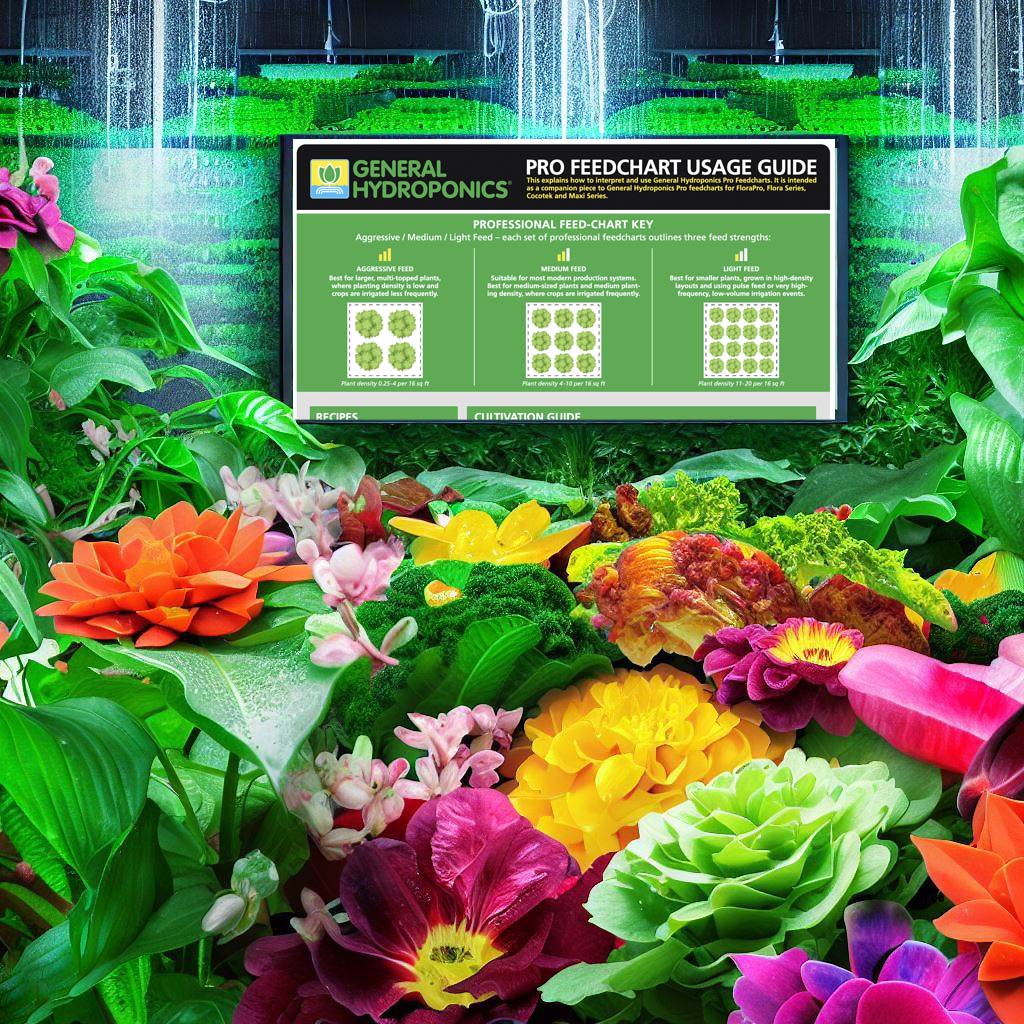
Tips and Tricks for Using a General Hydroponics Feed Chart
To help you use a general hydroponics feed chart more effectively, here are some tips and tricks that you can follow:
- Always shake your bottles before use. This will ensure that the nutrients and supplements are well mixed and evenly distributed in the solution.
- Follow the order of mixing as indicated on the chart. This will prevent any chemical reactions or precipitation that can affect the stability and compatibility of your nutrient solution.
- Use clean and calibrated measuring tools and devices. This will ensure that you measure and mix your nutrients and supplements accurately and consistently.
- Store your nutrients and supplements in a cool and dark place. This will prevent any degradation or contamination that can affect the quality and effectiveness of your products.
- Flush your system regularly to prevent salt buildup and nutrient lockout. This will ensure that your plants receive fresh and balanced nutrient solution every time.
General Hydroponics nutrients are synthetic formulations specifically crafted for use in sterile growing mediums like coco fiber, rock wool, perlite, clay pellets, and soilless hydroponic systems. However, their suitability for use in soil may also depend on the quality and purity of your water source.
Conclusion
A general hydroponics feed chart is a usage guide that tells you what nutrients and supplements to use for your hydroponic plants at different stages of their life cycle. It also tells you how to mix them correctly and adjust your water quality accordingly.
There are different types of general hydroponics feed charts available, such as FloraSeries 3-part feed chart, FloraPro feed chart, and Maxi Series feed chart. Each type has its own advantages and disadvantages, depending on your goals and preferences.
To use a general hydroponics feed chart, you need to follow some general steps, such as measuring your water volume and quality, selecting your feed strength and schedule, mixing your nutrients and supplements according to the chart, adjusting your pH and EC levels as needed, and monitoring your plants’ health and growth.
By following these steps and tips, you can use a general hydroponics feed chart effectively and achieve amazing results with your hydroponic plants.
FAQ
Here are some FAQs that you might have after reading this article:
What is the difference between FloraSeries 3-part feed chart and FloraSeries Performance Pack?
FloraSeries 3-part feed chart is a guide that tells you how to use the three products of FloraSeries: FloraGro, FloraMicro, and FloraBloom. FloraSeries Performance Pack is a bundle of products that includes FloraSeries 3-part nutrients plus four supplements: RapidStart (for root development), Floralicious Plus (for flavor enhancement), Liquid KoolBloom (for flowering boost), and Dry KoolBloom (for ripening boost).
What is the difference between FloraPro feed chart and Maxi Series feed chart?
FloraPro feed chart is a guide that tells you how to use the two products of FloraPro: FloraPro Grow and FloraPro Bloom. FloraPro is a 2-part powder-based nutrient system that is simple and economical for large-scale commercial growers. Maxi Series feed chart is a guide that tells you how to use the two products of Maxi Series: MaxiGro and MaxiBloom. Maxi Series is a 2-part dry concentrate nutrient system that is simple and versatile for different types of plants and systems.
How often should I flush my system?
The frequency of flushing your system depends on several factors, such as the type of system, the type of nutrients, the feed strength, the water quality, and the plant growth stage. However, a general rule of thumb is to flush your system at least once every two weeks or whenever you notice signs of mineral buildup or nutrient lockout.
How do I know if my plants are suffering from nutrient deficiencies or toxicities?
The best way to diagnose nutrient deficiencies or toxicities is to observe your plants’ appearance and behavior. Some common signs of nutrient deficiencies or toxicities are:
Yellowing or browning of leaves
Curling or wilting of leaves
Dropping or dying of leaves
Purple or red stems
Stunted or distorted growth
Delayed or poor flowering
Reduced or poor fruiting
If you notice any of these signs, you need to check your nutrient solution and adjust it accordingly.
Where can I find more information on general hydroponics feed charts?
You can find more information on general hydroponics feed charts on their website or in their product manuals. You can also consult with experienced growers or experts for advice.
Other sites:
Allotment Garden Growing Allotment diaries, photographs, advice about growing vegetables, fruits and herbs and general gardening
